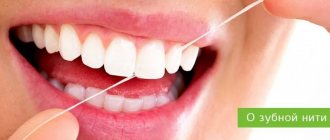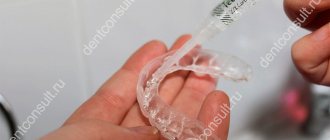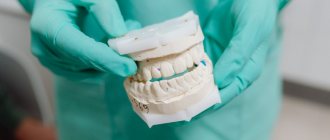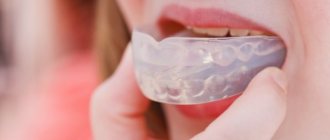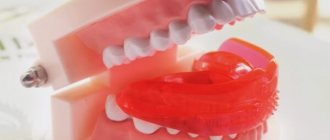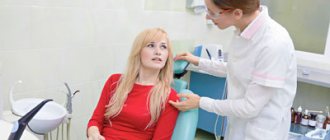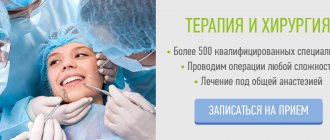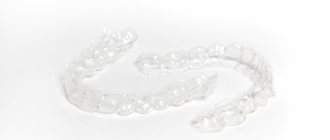9149
Trainers today are an excellent alternative to braces. They perform almost the same functions, but it is much easier to get used to them, since you can remove them periodically.
LM-Activator trainers can be used even before all teeth erupt , which greatly simplifies their alignment later.
What are LM-Activator trainers?
LM-activator is an orthodontic device for early treatment. It is a mouthguard made of highly elastic material, which patients quickly get used to. LM-activator is put on the teeth and is a two-jaw device, i.e. it is put on both the upper and lower teeth at once. It belongs to the category of dental trainers.
Read in detail about how to use trainers and what they are needed for here: Trainers for straightening teeth: description, varieties, tips for use.
Purpose and capabilities
The LM activator is necessary to restore the correct bite. But it also has additional functions that ensure that the effect remains long-lasting after the end of treatment. Namely:
- normalization of breathing and swallowing;
- elimination of bad habits that affect the position of teeth (sucking fingers, objects);
- normalization of muscle tone;
- elimination of speech defects.
In fact, the device not only straightens teeth, but affects the causes of malocclusion: bad habits, muscle weakness, etc. The result of wearing the LM activator is visible in the photo below.
“Before” and “After” wearing the LM activator
Indications for use
After the examination, the doctor may recommend an LM activator if the following disorders are detected:
- all kinds of bite pathologies (crossbite, open, deep, distal);
- crowding of the frontal teeth;
- gummy smile;
- reverse arrangement of teeth.
If a child has bad habits, such as thumb sucking, or other factors that can lead to malocclusion, the device is recommended for use as a preventive measure.
Since the sizes of the devices differ, it is possible to choose a model for a patient of any age. This method of treatment, compared to fixed orthodontic structures, is more comfortable. In the photo you can see young patients before and after treatment.
When is use recommended and contraindicated?
Indications for the use of the LM-activator are the following orthodontic pathologies:
- crowding of teeth in the area of incisors and canines;
- rotation of incisors and canines;
- gummy smile;
- open bite;
- distal bite;
- crossbite.
LM activators cannot be used when the dentist has placed a mesial bite or noted a displacement of the midline of the teeth by more than 3 mm. Also, the device is not suitable for patients with narrow dental arches.
Operating principle
The LM activator is made of very elastic hypoallergenic silicone. This is a trainer designed for both jaws. To facilitate breathing, special holes are provided in its front part. There are also grooves for the teeth to help them take the correct position during treatment.
The LM activator can be high or low. Models of the first type are mainly used to treat open bites. Low models have much more indications for use. Activators can have different sizes, be long or short.
Correction is carried out for temporary, mixed or permanent dentition. However, the LM activator is used quite rarely for the treatment of adults. For people with permanent dentition, wearing it is advisable in case of increased tooth wear, as well as TMJ dysfunction. This device helps straighten the dentition, normalize swallowing and respiratory functions, and relieve children from bad habits that lead to the formation of malocclusion.
Device design
LM-activator is made of safe, elastic silicone that easily fits any bite. It has the shape of perfect occlusion. Design elements:
- the basic shape, which is a semicircle with space for teeth;
- walls that prevent the device from falling out;
- lingual edges to help children with deep bites hold the device;
- positioners for teeth align the front row (incisors, canines, first premolars);
- buccal and lingual walls, aligning premolars and molars;
- breathing hole in the front wall.
The LM activator is quite convenient and easy to use, and its design is carefully thought out and suitable for different patients.
Types
LM activators are produced in different sizes and parameters. Each has its own purpose, so a doctor must select a specific device. Each product is sold in a container of its own color. In total, there are 37 types of activators for teeth.
4 main types of LM activator in different boxes
By height
Based on height, there are low and high varieties. The low model has broader indications for use, while the high model is specialized. It is designed for open bite. In addition to the enlarged sides, this LM-activator has thickened lateral sections of the walls in the area of the second premolars and molars.
By lenght
The availability of short and long LM activators on sale is explained by the fact that the device is often prescribed to children whose so-called “sevens” have not yet emerged. If parts of the molars are missing, wearing a long model is inconvenient, so a shortened one is used.
To size
LM activators are divided by size for ease of wearing. To select the appropriate device, the doctor uses a special line of LM-OrthoSizer. It helps to calculate the size between the second incisor and the canine and determine which product the patient requires. If there is crowding of teeth or diastema, the doctor gives preference to a larger or smaller size of the structure.
Ruler for selecting the size of the LM activator
How to use. Wearing rules
The LM activator is designed to be worn during sleep and for 2 hours during the day. The treatment itself takes place at night, when the trainer has a particularly strong effect on the position of the teeth, since it acts on them for a long time. Daytime hours are necessary to form the habit of holding the LM activator in the mouth.
The treatment phases are divided into active and retention periods. First, you need to wear the LM Activator every day and every night. Daytime hours are divided into intervals of 15-30 minutes, depending on how old the patient is and what the doctor recommends. For some children, a special program for getting used to the LM activator is being developed.
At the beginning of treatment, the doctor is visited every 4-5 weeks, then every 10 weeks. During the retention period, it is necessary to visit the dentist once every 6 months to make sure that the effect of treatment has not faded with age. Recommendations for wearing LM activators during retention are given by the doctor.
LM-Activators in the practice of an orthodontist
Orthodontic treatment of patients with pathology of the dental system is an integral part of complex dental treatment.
Words such as “plates” and “braces” have entered our lexicon along with such dental concepts as “filling”, “crown”, “denture”. It is already difficult to meet a teenager who has not worn braces in his life. More and more often, parents insist on orthodontic treatment for their children in early preschool age. It is no longer uncommon for children to be brought in for consultation with an orthodontist when they are cutting through their first pair of teeth and have a diastema.
Orthodontists have learned to effectively treat various pathologies of permanent occlusion. They have at their disposal all kinds of removable devices, braces systems, and maxillofacial surgery. Teenagers “cry” and wear whatever it takes to create a socially acceptable picture of a successful person, and adults are increasingly choosing to undergo bite and facial surgery to achieve the same goal. How much inconvenient, ineffective treatment that does not guarantee the stability of the treatment result could have been avoided by starting treatment during the formation of the dental system. Control and elimination of bad habits, treatment of pathology of the ENT organs (creating conditions for breathing through the nose), treatment of pathology of the supporting apparatus (elimination of the results of birth trauma, normalization of posture) can significantly reduce the risk of developing pathology. Better results can be achieved not by mechanical movement of teeth and surgical changes to the jaws, but by creating conditions for the formation of the dental system under physiological conditions.
We are talking about PREVENTION of dental anomalies and EARLY TREATMENT of the first manifestations of deviations from the norm. It is important here to educate parents about the need for breastfeeding, timely abandonment of the pacifier, combating bad habits of thumb sucking, mouth breathing, etc. Screening examination of the maximum number of children by an orthodontist is also very important. It is important to timely treatment of identified deviations of the dental system and systems that directly affect the formation of the bite, the health of the ENT organs, and the spine from normal.
Unfortunately, the system of medical examination of the population was destroyed in the sad 90s of the last century, “dental offices” in schools were closed, routine examinations of children in kindergartens stopped, and private dentistry does not rely on seeing children due to the low financial result compared to prosthetics on implants. And in vain.
At a children's appointment at ORTONIK, each child is examined “through the eyes of three specialists”: a therapist, a surgeon, and an orthodontist. Naturally, first of all, the level of oral hygiene is assessed and brought back to normal. Then therapeutic and surgical sanitation of the oral cavity begins. Children who need the help of an orthodontist undergo additional examination: diagnostic photos, control and diagnostic models of the jaws, x-rays. All examined patients are divided into 2 groups: a group requiring immediate orthodontic treatment using a particular device and a group requiring dynamic monitoring.
In the orthodontic treatment of ORTHONICS patients, we use removable plates, mono- and twin-block activators, and, of course, silicone activators.
From the many activators available on the market, we chose the Finnish-made LM activator. This choice was influenced by studying with the author of LM technology, Professor Katri Keski-Nisula, in January 2013 at the University of Turku. And the results obtained in the treatment of our patients in 2013 confirmed us in the correctness of this choice.
The LM Activator is convenient and effective in treating many types of malocclusion, including crowding, open bite, deep bite and distal bite.
The range of device sizes from 10 to 70 allows you to select a device for children of different ages with great accuracy. In addition, the LM activator requires only minimal adjustments. The time the patient spends in the chair ranges from 5 to 12 minutes. In addition, treatment with this device increases the intervals between visits to 6-12 weeks. Also, the same device can be used as a retainer. Current LM activator models are not effective for patients with skeletal class 3 disease and have therefore not been prescribed for them.
MATERIALS
In 2013, 102 patients of different ages were prescribed to use the LM-activator in treatment. Of these, 2 children with a primary dentition, 84 children with a removable dentition and 2 adult patients with a permanent dentition. Treatment began after a clinical examination, analysis of control and diagnostic models, photographic recording of the face and dentition. X-ray images: OPTG was prescribed to all patients from 7 years of age, TRG - for severe distal or mesial occlusion. One or two LM activators were used in each patient. The device was required to be changed if it was necessary to move to the next size or if the device was deformed due to “illegal” actions of a small patient. The size of the device was determined in accordance with the manufacturer's recommendations. Patients were advised to wear the device all night and 2 hours during the day. In fact, patients only wore the device at night. Single disciplined patients wore the device for an additional hour during the day.
The duration of observation of the group of patients from January 2013 is 12 months.
Examples of treatment:
L.A. age 10/3. Distal occlusion, deep incisal overlap, crowded teeth. LM activator model - No. 45 Low Short. Elimination of protrusion 12, 22, rotation 11,21, initial alignment of the lower incisors when using the device only at night for 12 months in 2013.
Fig.1-3 Date: 01/13/2013
Fig.4-6 Date: 12.2013
N.V. age 11/6. Car injury. Complete dislocation 11, impacted dislocation 21 22. LM-activator model - No. 50 Low Short. Extrusion with 21 22 elastic rings supported by a hook in the base of the apparatus. The device was used in parallel with removable dentures on the upper and lower jaws for four months.
Dates: 09/11/2012 - 01/18/2013 - 08/05/2013 - 12/26/2013
C.A. age 22/3. Model LM-activator - No. 60 Low Long was used as a retention device after orthodontic treatment.
DISCUSSION
Our statistics showed that it took from several days to 3-4 weeks to adapt to the device. Two patients required additional correction of the device in the sublingual area, the rest stopped complaining of discomfort from the device on the 3-4th day of daily use. By the end of the first month of treatment, all patients stopped “finding” the device on the pillow, except for 5 patients out of 102. These patients stopped treatment. The first photo-recorded improvements in tooth position were achieved within 4-6 weeks. Patients were seen every 6-8 weeks. The patient talked about his impressions of the device. At each subsequent examination, positive changes were noted. During a year of observation, the majority of children receiving treatment showed favorable intermaxillary relationships in the segment of incisors, canines and molars. The vertical gap in the frontal region closed with an open bite, the depth of the incisal overlap decreased with a deep bite, the dentition was aligned, a mesial step appeared in the molar area, and the canines showed almost full class I. And all this while using the device in almost 99% of children only at night.
The patient's stay in the clinic for the entire course of treatment was significantly less than with other techniques, because regular visits every 4-6 weeks took only 5-10 minutes each. The advantage of the LM activator is that it not only directs the eruption of teeth, but also simultaneously acts on the dental arches in the transverse and sagittal directions.
Parental education and support are always necessary when treating children with removable appliances, especially at the beginning of treatment. Most children quickly mastered the device; we received complaints from the parents of 8 patients over the course of a year due to repeated falls of the device from the child’s mouth during night sleep. In 7 children, the device stopped falling out of the mouth after 1-1.5 months of use. We were unable to call one child for an appointment due to parental refusal. Treatment discontinuation could be due to compliance problems, the child not wanting to wear the device, or the parents not being motivated enough to support it. Various psychosocial disorders in the families of these children were one of the main reasons for poor cooperation. Professor Katri Keski-Nisula's submissions suggested that the young age of patients would be the main limiting factor for widespread early treatment. In our practice, it turned out that the most important factor influencing compliance with the wearing regimen is the marital status, and not the age of the patients themselves. Based on ORTHONICS statistics, we cannot draw global conclusions about the effectiveness of treatment in early mixed dentition, but we will continue to monitor our patients. However, the results obtained are already encouraging. There are also results that we did not expect: the oral hygiene of patients wearing the LM activator and undergoing regular examinations is better than that of patients who do not need orthodontic treatment and undergo examinations only once every 6 months. The increase in caries and the increase in complicated forms of caries in these patients is 16% lower. Young patients, getting used to the doctor’s manipulations, easily accept other dental procedures: professional hygiene, dental treatment. The clinic’s workload for preventive appointments and pediatric dentist appointments has also increased, and financial results have also improved, which is important for a private clinic.
Conclusions:
The use of LM-activators in the practice of an orthodontist at a pediatric appointment, according to the results of treatment of orthodontic patients, is effective. The financial performance of a private dental clinic using LM activators is positive. We recommend using the LM activator in the practice of a pediatric dentist and an orthodontist.
Literature:
1 Persin L.S. "Orthodontics. Diagnosis and types of dentofacial anomalies."
2 W.Proffit Contemporary orthodontics.
Author of the article:
N.M. Sosnina, orthodontist. Family dentistry "ORTONIKA" Tolyatti, ortonika.ru
Proper care
During treatment, it is important to ensure that the child does not chew or chew the LM activator during the day. Otherwise, caring for the device is quite simple:
- after sleep, LM activators are cleaned using regular paste;
- During the day after use, the device is washed with warm water;
- In between wearing periods, the LM activator must be stored in a container.
If necessary, the LM activator for teeth can be processed in an autoclave or disinfected by boiling. There are also disinfection tablets.
Pros and cons of the device
The main advantages of the LM activator are:
- painless and relatively quick teeth straightening;
- wearing it allows not only to correct the bite, but also to develop the lower jaw;
- the material is safe and does not cause allergic reactions;
- wide size range;
- low price compared to other orthodontic treatment methods.
Based on reviews of LM activators, one can determine their disadvantages. They are associated with the need for constant wearing: not every child will agree to this. Parents have to motivate their little patient in different ways. At the same time, regularity and wearing the LM activator strictly according to the instructions is crucial in treatment.
Price issue
The price of the LM activator fluctuates around 4000-6000 rubles. Please remember that several devices may need to be changed during treatment as your child's jaws and facial bones grow and develop. Some people get by with just one trainer.
Straightening teeth with braces will cost much more, and their use is more uncomfortable and troublesome compared to trainers.
The main correction occurs at night. During the day, mouthguards can be worn at home, out of sight of prying eyes, this eliminates the feeling of discomfort and psychological stress due to the need to communicate with people during the treatment period.
Conclusions. Expert advice
The LM-activator is a simple and convenient device that provides relatively quick and painless restoration of bite in children. Its main advantage is that the device not only returns teeth to their place, but removes the cause of malocclusion: it weanes off bad habits, improves muscle tone, and helps the jaw develop correctly.
The purpose of the device must be determined by a doctor, since the LM activator cannot always be used. The specialist must also select the type of product in terms of height, width and size. If you wear it while your child is actively growing, you will have to change the size of the device once or even twice.
Proper use and proper care of the mouthguard, as well as good motivation of the child, are the main components of successful treatment. And you need to visit your doctor regularly to monitor your results.
Advantages and disadvantages
The list of positive aspects noted by dentists when using LM activators includes:
- Efficiency of bite correction;
- Aesthetics compared to braces;
- Simplicity and ease of use;
- Elimination of speech defects;
- Increased tone of the orbicularis oris muscle;
- Affordable price.
The device is used as a prophylactic agent to prevent the development of orthodontic anomalies, as well as severe malocclusions.
The disadvantages characteristic of elastic correctors are determined by the specifics of their design. The absence of metal elements, although it provides a convenient, aesthetic and painless restoration of the dentition, implies less pressure on the problem units. The consequence of this is an increase in the duration of correction - the average period, as a rule, is about one and a half years, and is also determined by the age of the patient and the specifics of the pathology. It is also worth considering that the technique of wearing the device requires compliance with a special protocol that prescribes tight closure of the dentition, so parents have to pay increased attention to how the child complies with medical recommendations.
Features of care and operation
The key factor in favor of activators is their aesthetics. Daytime wearing of the structure is limited to two-hour sessions, which greatly simplifies the child’s psychological adaptation. Installation at night, thanks to the special features of the system, eliminates the possibility of the trainer moving or falling out during sleep. The procedure for caring for the product does not require much effort: it is enough to regularly rinse the activator in running water, and in case of severe contamination, boil it for several minutes. The presence of a special storage case allows you to maintain the hygienic condition of the corrector.

